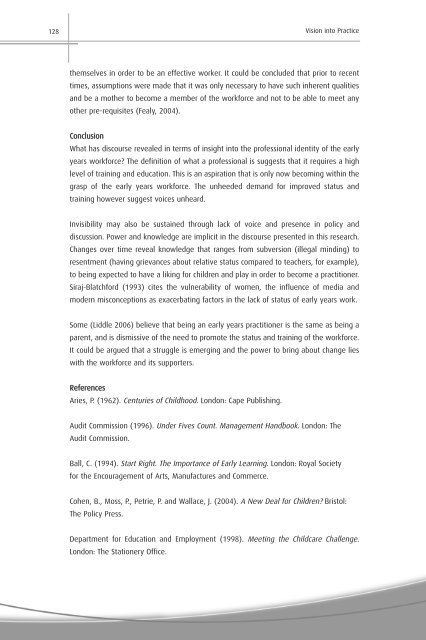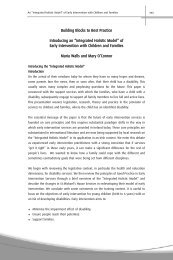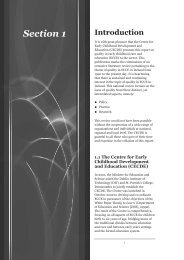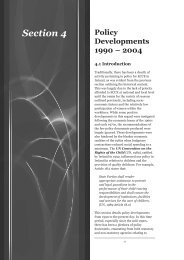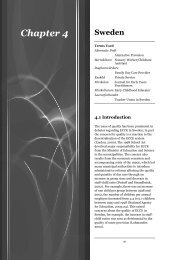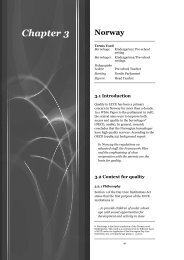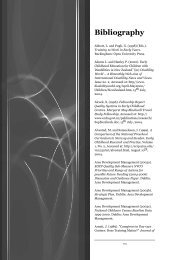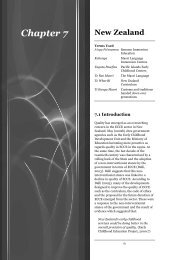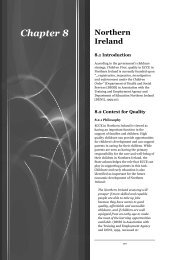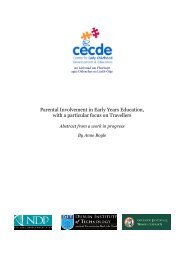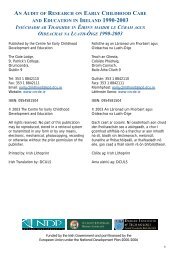Visions 08 sec 2.qxd - Centre for Early Childhood Development ...
Visions 08 sec 2.qxd - Centre for Early Childhood Development ...
Visions 08 sec 2.qxd - Centre for Early Childhood Development ...
- No tags were found...
Create successful ePaper yourself
Turn your PDF publications into a flip-book with our unique Google optimized e-Paper software.
128Vision into Practicethemselves in order to be an effective worker. It could be concluded that prior to recenttimes, assumptions were made that it was only necessary to have such inherent qualitiesand be a mother to become a member of the work<strong>for</strong>ce and not to be able to meet anyother pre-requisites (Fealy, 2004).ConclusionWhat has discourse revealed in terms of insight into the professional identity of the earlyyears work<strong>for</strong>ce? The definition of what a professional is suggests that it requires a highlevel of training and education. This is an aspiration that is only now becoming within thegrasp of the early years work<strong>for</strong>ce. The unheeded demand <strong>for</strong> improved status andtraining however suggest voices unheard.Invisibility may also be sustained through lack of voice and presence in policy anddiscussion. Power and knowledge are implicit in the discourse presented in this research.Changes over time reveal knowledge that ranges from subversion (illegal minding) toresentment (having grievances about relative status compared to teachers, <strong>for</strong> example),to being expected to have a liking <strong>for</strong> children and play in order to become a practitioner.Siraj-Blatch<strong>for</strong>d (1993) cites the vulnerability of women, the influence of media andmodern misconceptions as exacerbating factors in the lack of status of early years work.Some (Liddle 2006) believe that being an early years practitioner is the same as being aparent, and is dismissive of the need to promote the status and training of the work<strong>for</strong>ce.It could be argued that a struggle is emerging and the power to bring about change lieswith the work<strong>for</strong>ce and its supporters.ReferencesAries, P. (1962). Centuries of <strong>Childhood</strong>. London: Cape Publishing.Audit Commission (1996). Under Fives Count. Management Handbook. London: TheAudit Commission.Ball, C. (1994). Start Right. The Importance of <strong>Early</strong> Learning. London: Royal Society<strong>for</strong> the Encouragement of Arts, Manufactures and Commerce.Cohen, B., Moss, P., Petrie, P. and Wallace, J. (2004). A New Deal <strong>for</strong> Children? Bristol:The Policy Press.Department <strong>for</strong> Education and Employment (1998). Meeting the Childcare Challenge.London: The Stationery Office.


